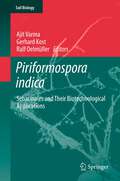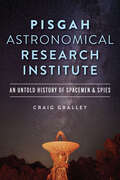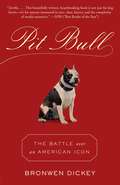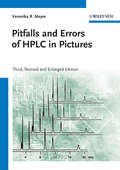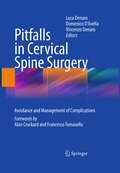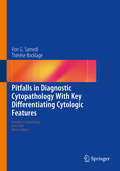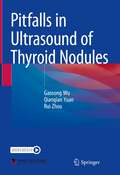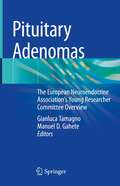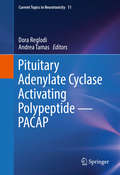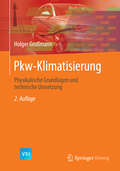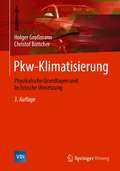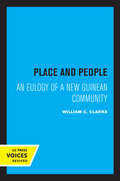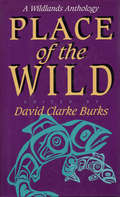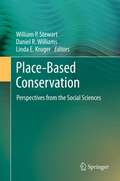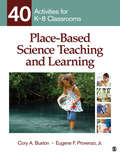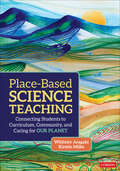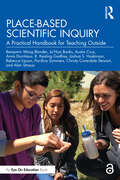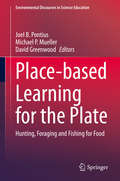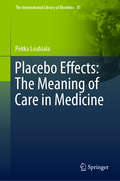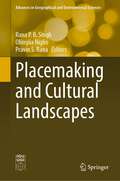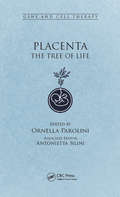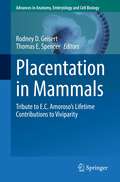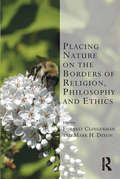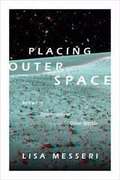- Table View
- List View
Piriformospora indica
by Ajit Varma Gerhard Kost Ralf OelmüllerSebacinales have emerged as a fascinating order with mutualistic plant-fungal symbionts that consists of exclusively beneficial fungi. This volume of Soil Biology presents an overview of the current results in Sebacinales research with a focus on the potential of these fungi in crop improvement and stress tolerance. The authors demonstrate that Sebacinales are not only extremely versatile in their associations with roots, but are also almost universally present as symptomless endophytes. With this extraordinary diversity, Sebacinales with the key fungus Piriformospora indica might possess remarkable significance in natural ecosystems. Their biotechnological applications are expected to improve the quality of crops while maintaining ecologically and economically sustainable production systems.
Pisgah Astronomical Research Institute: An Untold History of Spacemen & Spies
by Craig GralleyFor six decades western North Carolinians have asked the question: "What are those big satellite dishes doing behind that chain-linked fence?" In the early years of the site near Rosman, NASA gave public tours of the antennas it used to track space satellites. When the defense department took over, the tours stopped. Signs were posted that read "Unauthorized Entry Prohibited" and armed guards patrolled the site. Wild myths took root. Underground tunnels held nuclear missiles. The site was a submarine base. A city built underground held captive space aliens. Then, suddenly, DoD departed. New owners dusted off the satellite dishes and pointed them into deepest space. Public tours at the new Pisgah Astronomical Research Institute were reestablished and programs were created for a brand new mission-- science education. Now, local author Craig Gralley tells PARI's full story.
Pit Bull: The Battle over an American Icon
by Bronwen DickeyThe hugely illuminating story of how a popular breed of dog became the most demonized and supposedly the most dangerous of dogs--and what role humans have played in the transformation. When Bronwen Dickey brought her new dog home, she saw no traces of the infamous viciousness in her affectionate, timid pit bull. Which made her wonder: How had the breed--beloved by Teddy Roosevelt, Helen Keller, and Hollywood's "Little Rascals"--come to be known as a brutal fighter? Her search for answers takes her from nineteenth-century New York City dogfighting pits--the cruelty of which drew the attention of the recently formed ASPCA--to early twentieth-century movie sets, where pit bulls cavorted with Fatty Arbuckle and Buster Keaton; from the battlefields of Gettysburg and the Marne, where pit bulls earned presidential recognition, to desolate urban neighborhoods where the dogs were loved, prized--and sometimes brutalized. Whether through love or fear, hatred or devotion, humans are bound to the history of the pit bull. With unfailing thoughtfulness, compassion, and a firm grasp of scientific fact, Dickey offers us a clear-eyed portrait of this extraordinary breed, and an insightful view of Americans' relationship with their dogs.From the Hardcover edition.
Pitfalls and Errors of HPLC in Pictures
by Veronika R. MeyerThe third edition of this popular problem-solving guide for this widely-used method includes eleven completely new examples andseveral updated ones, adding up to 100 contributions about pitfalls and errors in HPLC. Each example is presented on a double page with thetext on the left-hand and a fi gure on the right-hand side, true to the motto 'a picture says more than a thousand words'. In addition, theauthor presents essential fundamentals as well as helpful strategies, such as equipment tests or quality assurance processes. New in this edition* Variability of the standard deviation* Infl uence of the acid type and concentration in the eluent* Water as an unintentional additive in the mobile phase* Inadequate purity of mobile phase water* Incomplete degassing* Inadequate stabilization of the extraction solvent* Tailing of phosphate compounds in the presence of steel* Different detection properties of diastereomers* Detector overload in ELSD* System suitability test* From repeatability to reproducibilityA must-have resource for all users - showing how to use HPLC efficiently and obtain reliable results.
Pitfalls in Cervical Spine Surgery
by Vincenzo Denaro Luca Denaro Domenico D'AvellaSpinal surgery is a unique area in the process of continuous development. New skills are applied daily in this delicate field by the spinal surgeon: this professional can be either an orthopaedic surgeon or a neurosurgeon dedicated to the treatment of spinal diseases. This book offers a comprehensive approach and reviews all of the possible errors encountered by spinal surgeons in the clinical practice. It is mainly directed towards young surgeons approaching spinal surgery and also to experienced surgeons with regards to complications related to the latest technologies in the spinal field. This approach of treating and understanding problems in cervical spine surgery is unique and will guide the reader towards an improved level of attention regarding pitfalls in cervical spine surgery, therefore fostering the ability of preventing major complications and medicolegal consequences.
Pitfalls in Diagnostic Cytopathology With Key Differentiating Cytologic Features
by Von G. Samedi Thèrése BocklageThis book provides cytopathologists a succinct but comprehensive reference covering common diagnostic dilemmas caused by normal, iatrogenic, inflammatory and reactive/reparative changes in cytology samples. This book will provide immediate access to these confounders, clearly illustrating key features and detailing the pitfalls these cells engender in all cytologically accessible body sites. The text is organized in chapters corresponding to cytologically accessible body sites/organ systems. Each chapter's discussions are further organized by general categories of confounders (i. e. , normal contaminants, inflammatory, infectious and iatrogenic), with special attention to site specific confounders. Pitfalls in Diagnostic Cytopathology With Key Differentiating Cytologic Features will be of great value to practicing pathologists, pathology residents, cytopathology fellows, cytotechnology technologists and students.
Pitfalls in Ultrasound of Thyroid Nodules
by Rui Zhou Gaosong Wu Qianqian YuanThyroid nodules with benign signs might be subjectively diagnosed as malignant, leading to over treatment, and nodules with malignant signs might be regarded as benign causing insufficient curing. In order to improve the accuracy rate of thyroid nodules, this book analysed ultrasound diagnosis for thyroid nodules in multiple difficult and misdiagnosed cases from thyroid surgeons’ perspective and closely combined ultrasound imaging with clinical information, including ultrasound images and palpation of thyroid nodules, ultrasound detection video, gross specimen and pathologic diagnosis to interpret the ultrasound images of thyroid nodules, which can be a reference for thyroid surgeons and beginner.This is the first book which has systematically summarized the ultrasound thyroid nodules from the perspective of surgeons, closely combining the imaging and clinical characteristics.Contains abundant clinical cases, and can be used as a teaching book for beginner and an expert-led training course.Help surgeons to better carry out clinical work, making up for the lack of knowledge in anatomy and clinical pathology.Helps surgeons to perform the preoperative ultrasound evaluation, in order to decrease the missed and misdiagnosed nodules.
Pituitary Adenomas: The European Neuroendocrine Association’s Young Researcher Committee Overview
by Gianluca Tamagno Manuel D. GaheteStemming from the ENEA Young Researcher Committee, this didactical book comprehensively discusses all aspects of pituitary adenomas, particularly the practical aspects arising in everyday clinical practice. Offering valuable tips, it serves as a guide for young trainee endocrinologists facing their first cases of pituitary adenomas. It also includes illustrative clinical cases of acromegaly, prolactinomas, Cushing’s disease, and TSHomas. In addition, a Questions & Answers section is available online. The mix of fresh enthusiasm and well-established expertise in the field provided by the editors and the committee they belong to make the book both solid and innovative, with an appropriate balance between the traditional knowledge and the most exciting innovations from recent or ongoing research. Written and edited by young researchers active in the field of neuroendocrinology, it is a valuable resource for anyone working or interested in the field.
Pituitary Adenylate Cyclase Activating Polypeptide — PACAP
by Dora Reglodi Andrea TamasThe first comprehensive book to cover all aspects of the last 25 years of PACAP (pituitary adenylate cyclase activating polypeptide) research, this book contains contributions from virtually all the leading researchers in the field, and addresses some of the following topics: evolutionary aspects of PACAP, distribution and occurrence of PACAP and its receptors, hormonal effects of PACAP, intracellular signaling, effects on cellular proliferation and differentiation, protective effects of PACAP, behavioral effects of PACAP, developmental aspects of PACAP, other physiological effects of PACAP (cardiovascular, thermoregulatory), human studies, drug design, metabolism and transport. This compendium can serve as an important reference for researchers and students in PACAP research and can also be a thorough introduction for those in related fields.
Pkw-Klimatisierung
by Holger GroßmannBasierend auf langjährige experimentelle Erfahrungen werden elementare physikalische Ansätze verwendet. Damit lassen sich die Zusammenhänge der Pkw-Klimatisierung transparent darstellen. Beschrieben werden typische Betriebsarten eines Pkw im Winter und im Sommer mit und ohne Kälteanlage. Hierzu ist auch ein Kapitel der Klimaphysiologie gewidmet. Ausführliche Beispiele dienen zur Vertiefung der gelesenen Kapitel. Mathematisch aufwändige Berechnungen und Tabellen sind im Anhang zusammengestellt. So kann bei Bedarf nachgeschlagen werden. Zu den besonderen Themen gehören zum Beispiel "Luftaustausch der Karosserie mit der Umgebung", "Absorbierte Sonneneinstrahlung der Karosserie", "Aufheizung der Luft an der Motorhaube", "Prüfstände" und "Straßenmessungen".
Pkw-Klimatisierung: Physikalische Grundlagen und technische Umsetzung (VDI-Buch)
by Holger Großmann Christof BöttcherBasierend auf langjährige experimentelle Erfahrungen werden elementare physikalische Ansätze verwendet. Damit lassen sich die Zusammenhänge der Pkw-Klimatisierung transparent darstellen. Beschrieben werden typische Betriebsarten eines Pkw im Winter und Sommer. Hierzu ist auch ein Kapitel der Klimaphysiologie gewidmet. Ausführliche Beispiele dienen zur Vertiefung der gelesenen Kapitel. Mathematisch aufwändige Berechnungen und Tabellen sind im Anhang zusammengestellt.Zu den besonderen Themen gehören z.B.:· Luft- und Wärmeströme· Sonneneinstrahlung· Wärmeübertrager· Prüfstände· Energieersparnis· Elektrisch betriebene Pkw Eine Zusammenstellung wichtiger Normen und Richtlinien erleichtert deren Suche
Place and People: An Ecology of a New Guinean Community
by William C. ClarkeThis title is part of UC Press's Voices Revived program, which commemorates University of California Press’s mission to seek out and cultivate the brightest minds and give them voice, reach, and impact. Drawing on a backlist dating to 1893, Voices Revived makes high-quality, peer-reviewed scholarship accessible once again using print-on-demand technology. This title was originally published in 1971.
Place of the Wild: A Wildlands Anthology
by John Davis David Abram Kirkpatrick Sale Max Oelschlaeger David Clarke Burks Margaret Hayes YoungWhere and what is the place of the wild? Is the goal of preserving biodiversity across the landscape of North America compatible with contemporary Western culture?Place of the Wild brings together original essays from an exceptional array of contemporary writers and activists to present in a single volume the most current thinking on the relationship between humans and wilderness. A common thread running through the volume is the conviction that everyone concerned with the natural world -- academics and activists, philosophers and poets -- must join forces to re-establish cultural narratives and shared visions that sustain life on this planet.The contributors apply the insights of conservation biology to the importance of wilderness in the 21st century, raising questions and stimulating thought. The volume begins with a series of personal narratives that present portraits of wildlands and humans. Following those narratives are more-analytical discourses that examine conceptions and perceptions of the wild, and of the place of humanity in it. The concluding section features clear and resonant activist voices that consider the importance of wildlands, and what can be done to reconcile the needs of wilderness with the needs of human culture.
Place-Based Conservation
by Linda E. Kruger Suzette Dailey William P. StewartThe concept of "Place" has become prominent in natural resource management, as professionals increasingly recognize the importance of scale, place-specific meanings, local knowledge, and social-ecological dynamics. Place-Based Conservation: Perspectives from the Social Sciences offers a thorough examination of the topic, dividing its exploration into four broad areas. Place-Based Conservation provides a comprehensive resource for researchers and practitioners to help build the conceptual grounding necessary to understand and to effectively practice place-based conservation.
Place-Based Science Teaching and Learning: 40 Activities for K-8 Classrooms
by Dr Cory A. Buxton Dr Eugene F. ProvenzoForty classroom-ready science teaching and learning activities for elementary and middle school teachersGrounded in theory and best-practices research, this practical text provides elementary and middle school teachers with 40 place-based activities that will help them to make science learning relevant to their students. This text provides teachers with both a rationale and a set of strategies and activities for teaching science in a local context to help students engage with science learning and come to understand the importance of science in their everyday lives.
Place-Based Science Teaching: Connecting Students to Curriculum, Community, and Caring for Our Planet
by Whitney Aragaki Kirstin MilksJumpstart your imagination and transform your science classroom by centering place-based learning Identity, community, and place are tightly connected and can be leveraged to deepen science learning for students. Place-Based Science Teaching offers K-12 science educators an innovative approach to building learning experiences that embrace the rich and varied knowledge held by people, both past and present, about the places we call home. This book helps teachers to foster greater personal investment of students in their learning, as well as develop NGSS-informed authentic problem-solving and critical reasoning skills. The book will also help teachers create and find joy in their classrooms by connecting lessons to local environments, cultural heritage, and global issues. Written by nationally recognized STEM educators Whitney Aragaki and Kirstin Milks, the book blends inspiring storytelling with practical frameworks and resources. Chapters will take you behind the scenes into innovative classrooms, detailing high-impact, standards-aligned activities and sharing educator stories from diverse settings. Grounded in cutting-edge research and real-world examples, Place-Based Science Teaching Introduces the Place Based Science Teaching Framework that asks "where are you," "when are you," "who are you," and "who are we together" as a way to connect learning to local and global contexts Provides classroom-ready lessons and case studies from many educational settings, aligned with NGSS and centered on belonging, access, and engagement Offers strategies for virtual spaces and digital perspectives to enhance teaching in an increasingly online world Includes actionable reflection prompts designed to help teachers explore their own positionality and better connect with their students and communities This book will encourage educators and administrators alike to transform science learning into an opportunity for building empathy, connection, and hope. Place-Based Science Teaching is designed to help teachers foster a sense of place and stewardship among their students, and address peace- and justice-focused solutions that encourage students to care for their communities, think critically about global challenges, and develop the agency to lead for generations to come.
Place-Based Science Teaching: Connecting Students to Curriculum, Community, and Caring for Our Planet
by Whitney Aragaki Kirstin MilksJumpstart your imagination and transform your science classroom by centering place-based learning Identity, community, and place are tightly connected and can be leveraged to deepen science learning for students. Place-Based Science Teaching offers K-12 science educators an innovative approach to building learning experiences that embrace the rich and varied knowledge held by people, both past and present, about the places we call home. This book helps teachers to foster greater personal investment of students in their learning, as well as develop NGSS-informed authentic problem-solving and critical reasoning skills. The book will also help teachers create and find joy in their classrooms by connecting lessons to local environments, cultural heritage, and global issues. Written by nationally recognized STEM educators Whitney Aragaki and Kirstin Milks, the book blends inspiring storytelling with practical frameworks and resources. Chapters will take you behind the scenes into innovative classrooms, detailing high-impact, standards-aligned activities and sharing educator stories from diverse settings. Grounded in cutting-edge research and real-world examples, Place-Based Science Teaching Introduces the Place Based Science Teaching Framework that asks "where are you," "when are you," "who are you," and "who are we together" as a way to connect learning to local and global contexts Provides classroom-ready lessons and case studies from many educational settings, aligned with NGSS and centered on belonging, access, and engagement Offers strategies for virtual spaces and digital perspectives to enhance teaching in an increasingly online world Includes actionable reflection prompts designed to help teachers explore their own positionality and better connect with their students and communities This book will encourage educators and administrators alike to transform science learning into an opportunity for building empathy, connection, and hope. Place-Based Science Teaching is designed to help teachers foster a sense of place and stewardship among their students, and address peace- and justice-focused solutions that encourage students to care for their communities, think critically about global challenges, and develop the agency to lead for generations to come.
Place-Based Scientific Inquiry: A Practical Handbook for Teaching Outside
by Benjamin Wong Blonder Ja'Nya Banks Austin Cruz Anna Dornhaus R. Keating Godfrey Joshua S. Hoskinson Rebecca Lipson Pacifica Sommers Christy Stewart Alan StraussLearn how to facilitate scientific inquiry projects by getting out of the classroom and connecting to the natural environment—in your schoolyard, or in your community! Providing a contemporary perspective on how to do scientific inquiry in ways that can make teachers’ lives easier and students’ experiences better, this book draws on authentic inquiry, engaging with communities, and teaching through project-based learning to help students design and carry out scientific inquiry projects that are grounded in their local places. This accessible guide will help you to develop skills around facilitation, team building, and learning outdoors in schoolyards and parks, acting as a go-to toolkit for teachers to help build confidence and skills in these areas. Written according to the Next Generation Science Standards, this book supports teachers in fostering community engagement and a justice-first classroom. The approachable resources included in this book will help teachers with all levels of experience succeed in empowering students grades 3–12 in their science learning. Additional support materials including template documents for student use and for teacher planning, as well as examples of real student work, are available online. The Open Access version of this book, available at www.taylorfrancis.com, has been made available under a Creative Commons Attribution (CC-BY) 4.0 license
Place-based Learning for the Plate: Hunting, Foraging and Fishing for Food (Environmental Discourses in Science Education #6)
by Michael P. Mueller David Greenwood Joel B. PontiusThis edited volume explores 21st century stories of hunting, foraging, and fishing for food as unique forms of place-based learning. Through the authors’ narratives, it reveals complex social and ecological relationships while readers sample the flavors of foraging in Portland, Oregon; feel some of what it’s like to grow up hunting and gathering as a person of Oglala Lakota and Shoshone-Bannock descent; track the immersive process of learning to communicate with rocky mountain elk; encounter a road-killed deer as a spontaneous source of local meat, and more.Other topics in the collection connect place, food, and learning to issues of identity, activism, spirituality, food movements, conservation, traditional and elder knowledge, and the ethics related to eating the more-than-human world. This volume will bring lively discussion to courses on place-based learning, food studies, environmental education, outdoor recreation, experiential education, holistic learning, human dimensions of natural resource management, sustainability, food systems, environmental ethics, and others.
Placebo Effects: The Meaning of Care in Medicine (The International Library of Bioethics #81)
by Pekka LouhialaThis book provides a perspective on the concepts placebo and placebo effects, which has been missing so far: a detailed analysis of the history of the terms, their current use, suggested alternatives and the implications of the conceptual confusion. Everybody knows something about placebos and placebo effects. If, however, people are asked to define the concepts, the spectrum becomes wide. Does 'placebo' refer to an inert treatment or does it cover all elements of the patient-physician-interaction except for pharmacological or other physiological mechanisms? Furthermore, if, by definition, a placebo has no effect, what sense does it make to talk about a 'placebo effect'? Even in scientific literature the concepts ‘placebo’ and ‘placebo effect’ are used in many senses and often in a confusing way. While this book discusses many issues which keep puzzling physicians, it also covers the historical developments of the concepts of placebo and placebo effect as well as the conceptual confusion in the definitions. This book is intended for physicians, philosophers, psychologists and any other people interested in placebos, placebo effects and the physician-patient relationship.
Placemaking and Cultural Landscapes (Advances in Geographical and Environmental Sciences)
by Pravin S. Rana Olimpia Niglio Rana P. B. SinghPlacemaking and cultural landscapes are worldwide multidisciplinary global concerns that cover many points of view of the common impacts of socio-economic cultural and rights jurisprudence planning, wellbeing and related advancements. Concerned with the complex interactions between the development and environment of those factors, it is important to seek ways, paths and implications for framing sustainability in all social activities. This book is mostly based on the 10th ACLA – Asian Cultural Landscape Association International Webinar Symposium that took place during September 26–27, 2020, in the Banaras Hindu University, Varanasi, India. It examines contemporary social–cultural issues in the context of the United Nations Sustainable Development Goals (UN-SDGs) and associated cultural and sacred landscapes. There, the emphasis is on awakening deeper cultural sensitivity in harmonizing the world and the role of society and spiritual systems, drawing upon multi-disciplinary and cross-cultural interfaces—all within the scope of the future of the earth. The book’s chapters add a new dimension of cultural understanding in the broad domain of emerging human geoscience, considered as key policy science for contributing towards sustainability and survivability science together with future earth initiatives.
Placenta: The Tree of Life (Gene And Cell Therapy Ser. #2)
by Ornella ParoliniLong regarded as biological waste, the placenta is gaining momentum as a viable product for clinical use. Due to their unique properties, placental cells and derivatives show great promise in curing various diseases. Utilizing contributions from world-renowned experts, Placenta: The Tree of Life considers the therapeutic potential of these cells. I
Placentation in Mammals: Tribute to E.C. Amoroso’s Lifetime Contributions to Viviparity (Advances in Anatomy, Embryology and Cell Biology #234)
by Rodney D. Geisert Thomas E. SpencerThe present volume of the book series Advances in Anatomy, Embryology and Cell Biology brings together current reviews from leading experts to address the diversity of placentation by which species establish and maintain pregnancy. Development of viviparity and placentation in rodents, dogs, pigs, cattle, horses, marsupials, primates and elephants are discussed. The development of viviparity in mammals, including some invertebrate species, required the adaptation of the placenta to serve as a functional conduit for interplay between the semiallograftic fetus with the maternal uterus. Although the ‘placenta’ protects the fetus from maternal immune rejection and provides oxygen and nutrient flow to support it to term across all the species, structural differentiation of this fetal-maternal interface can vary from simple to very complex. E.C. Amoroso contributed greatly to our early understanding and knowledge of placentation across a great variety of species. His work on placentation provides numerous illustrations and histological sections which are used for teaching and stimulating research today. With this book, we want to pay tribute to his lifetime contributions to the field by reviewing our current understanding of the development of viviparity and placentation in different species. The book is written for researchers, physicians and medical students working in the field of reproductive science or with an interest in placentation and viviparity.
Placing Nature on the Borders of Religion, Philosophy and Ethics (Transcending Boundaries in Philosophy and Theology)
by Forrest Clingerman Mark H. DixonThe natural world has been "humanized": even areas thought to be wilderness bear the marks of human impact. But this human impact is not simply physical. At the emergence of the environmental movement, the focus was on human effects on "nature." More recently, however, the complexity of the term "nature" has led to fruitful debates and the recognition of how human individuals and cultures interpret their environments. This book furthers the dialogue on religion, ethics, and the environment by exploring three interrelated concepts: to recreate, to replace, and to restore. Through interdisciplinary dialogue the authors illuminate certain unique dimensions at the crossroads between finding value, creating value, and reflecting on one's place in the world. Each of these terms has diverse religious, ethical, and scientific connotations. Each converges on the ways in which humans both think about and act upon their surroundings. And each radically questions the damaging conceptual divisions between nature and culture, human and environment, and scientific explanation and religious/ethical understanding. This book self-consciously reflects on the intersections of environmental philosophy, environmental theology, and religion and ecology, stressing the importance of how place interprets us and how we interpret place. In addition to its contribution to environmental philosophy, this work is a unique volume in its serious engagement with theology and religious studies on the issues of ecological restoration and the meaning of place.
Placing Outer Space: An Earthly Ethnography of Other Worlds
by Lisa MesseriIn Placing Outer Space Lisa Messeri traces how the place-making practices of planetary scientists transform the void of space into a cosmos filled with worlds that can be known and explored. Making planets into places is central to the daily practices and professional identities of the astronomers, geologists, and computer scientists Messeri studies. She takes readers to the Mars Desert Research Station and a NASA research center to discuss ways scientists experience and map Mars. At a Chilean observatory and in MIT's labs she describes how they discover exoplanets and envision what it would be like to inhabit them. Today's planetary science reveals the universe as densely inhabited by evocative worlds, which in turn tells us more about Earth, ourselves, and our place in the universe.
